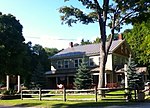Salisbury Fish Hatchery
Buildings and structures completed in 1931Buildings and structures in Salisbury, VermontFish hatcheries in the United StatesGovernment buildings on the National Register of Historic Places in VermontHistoric districts on the National Register of Historic Places in Vermont ... and 3 more
NRHP infobox with nocatNational Register of Historic Places in Addison County, VermontUse mdy dates from August 2023

The Salisbury Fish Hatchery is a state-operated fish hatchery on Vermont Route 53 in Salisbury, Vermont. Established in 1931, it produces broodstock trout for distribution to the other hatcheries in the state. Its facilities were listed on the National Register of Historic Places in 1994. The facility may be toured by arrangement, but there is no visitors center.
Excerpt from the Wikipedia article Salisbury Fish Hatchery (License: CC BY-SA 3.0, Authors, Images).Salisbury Fish Hatchery
Lake Dunmore Road,
Geographical coordinates (GPS) Address Nearby Places Show on map
Geographical coordinates (GPS)
| Latitude | Longitude |
|---|---|
| N 43.924722222222 ° | E -73.096388888889 ° |
Address
Lake Dunmore Road 645
05769
Vermont, United States
Open on Google Maps







